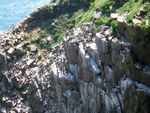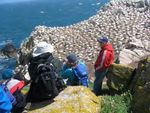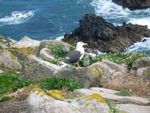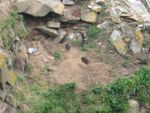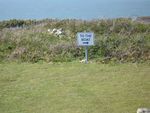Institute of Biology of Ireland visits the Great Saltee Island, Co. Wexford
←
→
Page content transcription
If your browser does not render page correctly, please read the page content below
Institute of Biology of Ireland visits the Great Saltee Island,
Co. Wexford
Activity No 6 of the IBIOLI Activity Series 2015
Figure 1 Looking NE along the cliffs on Great Saltee
The day, Saturday June 6th, was our planned visit to the Great Saltee Island, just over 5km off the
coast of Wexford; this was Activity No 6 of the IBIOLI Activity Series for 2015. In the days prior to
our visit, weather was quite inclement and seas were running strong. With fingers crossed we were
assured by our ferryman skipper on the eve of our trip that “he would manage it”, and indeed he did
managed it in style!. The Great Saltee is the most famous bird sanctuary in Ireland and is very popular
with both day-trippers and birdwatchers alike. These islands are privately owned and are rated as one
of the world's major bird sanctuaries.
Figure 2 Departing for the Great Saltee
Two boat loads of members of the IBIOLI and the public
left the very beautiful and peaceful harbour at Kilmore
Quay. We had just rounded the habour wall and into the
open sea when that apparent ‘peace’ was very soon
shattered. The open sea still running very strong, was
accompanied by a stiff SE wind that churned up rather
challenging waves and cross currents. Declan, our skipper
urged us to take shelter in the cabin. The trottle was
opened ‘full’ and the roller coaster, wave vaulting trip to
the island had begun.
Figure 3 Vaulting over the waves on the way to the Great
SalteeWaves crashed into our boat and the salt water sprayed over its deck as our competent skipper read the
currents and rode the waves until he landed us safely onto the island. One of our group described the
sea journey as a most memorable element of the trip.
Figure 4 Dedication Plaque to Prince Michael the First
A stone plaque dedicated to Prince Michael the First who
purchased the island in December 1943, welcomed us onto the
island. Since his death in January 1998 the islands are now
owned by his five sons Michael, John, Manfred, Paul, Richard
and daughter Anne. He is buried in the family vault in Bannow
Bay, Co.Wexford. His title was passed on to his eldest son,
Michael.
We were so fortunate to have the expertise of Chris Honan, an
ornithologist. His knowledge of the island and the birds that live
and breed there go back for many years, and he freely shared
that great resource with our group. He led us to the ‘Throne’,
and through a bluebell field to the first bird colony.
Figure 5 Chris Honan freely shared his expertise
Figure 6 The
Bluebell and
Campion field
Sitting there on the rocks along the island’s edge, we
absorbed the absolute beauty of the island, its birds, the sea
and sunshine; Chris Honan set the whole scene by placing
it in the context of Europe’s largest sea bird breeding
colony as he identified for us the Guillimots, the Razor
Bills, the Oyster Catchers, the Puffins (just a few as they return to their nesting burrows towards
nighfall), Greater Black-Backed and Lesser Black-Backed Gulls, Herring Gulls, Choughs, Fulmers,
Kittiwakes (with the black wing tips), Gannets (with their distinctive yellow heads), Rock Pippets,
Shags (with those green eyes), and Cormorants.
Figure 7 Introduction to the first of many sea bird
breeding colonies on the island
He enlightened us further by gradually unreeling useful
and fascinating facts on particular species – their life
expectancy, their sea journeys, their breeding and
feeding habits, the hierarchy of nesting on the rock
faces and their particular adaptive characteristics such
as egg shape/structure, flight take off platforms and
other interesting items of information that gripped the
imagination of the whole group. He also explained that the Saltees lie on an important migratory route
and a popular stopping-off place for spring and autumn migrants. As we sat on the rocks eating our
lunch snacks, we obseved a number of the breeding population of Grey Seals. This is one of the veryfew breeding sites in eastern Ireland. Up to 120 breeding seals are present in autumn and up to 20 pups
are produced annually.
Figure 8 Lunch break on the island
This first resting spot provided us with microcosmic views
of what we were later likely to see on the island. And
indeed, much more was to follow as we proceeded to cross
to the North Eastern end of the island. Chris and his
colleague, Tom Kealy, also an ornithologist gradualy, and
tantalisingly fed us with just sufficient information to raise
our eagnerness and wonderment of what we were to expect
in that NE corner of the island – but
they did not kill off our anticipation!
Figure 9 Various adaptations allow the
sea birds breed on the cliff faces
In fact, Jack who was ahead of the
group and who had a sneak preview as
he peered over the knoll, came chasing
back to meet the main body of the
group advising them to creep over the
hill and allow the indescribable Gannet
colony gradually unfold before their
eyes, just over the horizon.
Figure 10 The main Gannet colony
He had been enthralled and ecstatic with
the excitement of seeing those thousands
of pairs of breeding Gannets and their
chicks in that orderly chaos on the tilting
rock as if it were orientated towards the
sun. In a few moments the rest of the
group were able to join with him in their
absolute admiration of nature. Watching
at close up I could only marvel at the
total control of those large Gannets as
they come in to land and take to the air
against a stiff wind. Even more
fascinating was watching them dive into the sea from +25 metres; they penetrate the waves to great
depths at speeds of up to 100km/h. Their bodies are adapted to this entry speed by having air pockets
under their wings and in their wing feathers. Even a high velocity bullet will almost stop dead after
penetration of a few feet into the water!
Figure 11 Chris and members observing the Gannets
The Gannet colony has continued to expand and
Chris pointed out where new colonies have
established over the past 20 years. Vast numbers
of Guillemots and Razorbills, and the occasionalShag, intermingled with the Gannets, also pack
the ledges and create a frightful incessant din
Figure 12 A pair of Gannets in bonding display
after a return from a fishing trip
which only at night abates a little. The Fulmars
too play their part in this vast kaleidoscope of
splendour as they float effortlessly on the
updraughts.
Figure 13 The Greater Black-Backed 'protecting' its
pair of chicks (heavily camouflaged – in front and
above the back)
The Greater Black-Backed Gull protected their
chicks on the ground with noisy ‘squaking’ or
‘dive-bombed’ would-be intruders with a
shrieking screech – a good reason to wear a hat!
Figure 14 Puffins return to their nests (centre of
picture)
Figure 15 With reluctance we headed for the boat
home
With reluctance, we made our way back along the cliffs to view again the great variety of sea birds and
to reinforce our identification skills. In fact, one of our members was heard to utter that he ‘didn’t want
to leave the island yet’. On our way and as evening fell, the sight of the Puffins congregating in small
groups near their nestling burrows presented a marvellous sight.
Figure 16 On board the RIB, returning to Kilmore Quay (in calmer waters)
We departed the island in two boats but this time the seas has greatly abated
(much to the pleasure of a few of us). Our destination was a source of fish
and chips and other great fish dishes in the exceptionally busy ‘blue
coloured’ restaurant close to the quay. Not only did we all enjoy the
marvellous island experience and, as the photo shows, some of our Council
members also enjoyed their fish and chips.You can also read





